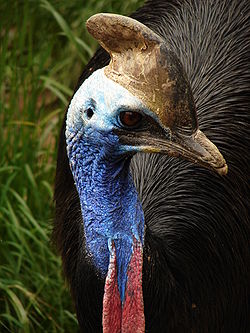Top Qs
Timeline
Chat
Perspective
Casuariidae
Family of birds From Wikipedia, the free encyclopedia
Remove ads
The bird family Casuariidae /kæsjuːəˈraɪ.ɪdiː/ has four surviving members: the three species of cassowary and the emu.
All living members of the family are very large flightless birds native to Australia-New Guinea.[2]
Remove ads
Species
- † Emuarius Boles, 1992 (emuwaries) (Late Oligocene – Late Miocene)
- † E. gidju (Patterson & Rich 1987) Boles, 1992
- † E. guljaruba Boles, 2001
- Casuarius Brisson, 1760 (cassowary)
- † C. lydekkeri Rothschild, 1911 (Pygmy cassowary)
- C. casuarius (Linnaeus, 1758) (Southern cassowary)
- C. unappendiculatus Blyth, 1860 (Northern cassowary)
- C. bennetti Gould, 1857 (Dwarf Cassowary)
- C. b. westermanni (Sclater, 1874) (Papuan dwarf cassowary)
- C. b. bennetti Gould, 1857 (Bennett's cassowary)
- Dromaius Vieillot, 1816 (emu)
- †D. arleyekweke Yates & Worthy 2019
- †D. ocypus Miller 1963
- D. novaehollandiae (Latham, 1790) (Emu)
- †D. n. diemenensis Le Souef, 1907 (Tasmanian emu)
- †D. n. minor Spencer, 1906 (King Island emu)
- †D. n. baudinianus Parker, SA, 1984 (Kangaroo Island emu)
- D. n. novaehollandiae (Latham, 1790) (Emu)
Remove ads
Systematics and evolution
The fossil record of casuariforms is interesting, but not very extensive.
Some Australian fossils initially believed to be from emus were recognized to represent a distinct genus, Emuarius,[3] which had a cassowary-like skull and femur and an emu-like lower leg and foot.
Footnotes
References
Wikiwand - on
Seamless Wikipedia browsing. On steroids.
Remove ads

